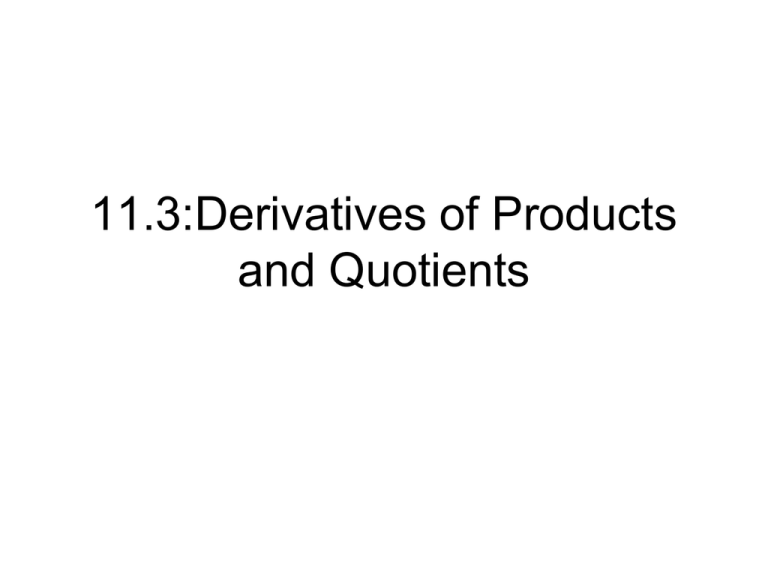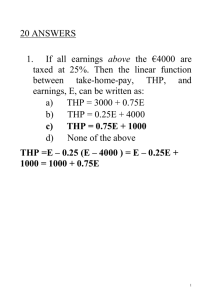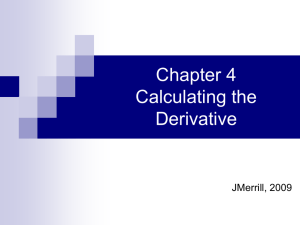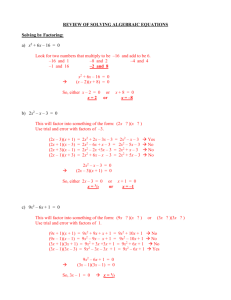Lesson 11.3: Derivatives of Products and Quotients
advertisement

11.3:Derivatives of Products and Quotients Can you find the derivatives of the following functions? 1) 2) 3) 4) f(x) = x2 x4 f(x) = 3x3 (2x2 – 3x + 1) f(x) = 5x8 ex f(x) = x7 ln x ** You can find the derivative for problem 1 and 2 easily by multiply two functions, but not for problem 3 and 4. ** You can find the derivative for all of the above problems using the limit definition, but it can be a long and tedious process As you know in section 10.5, the derivative of a sum is the sum of the derivatives. F(x) = u(x) + v(x) F’(x) = u’(x) + v’(x) Is the derivative of a product the product of the derivatives? NO Derivatives of Products Theorem 1 (Product Rule) If f (x) = u(x) v(x), and if u ’(x) and v ’(x) exist, then f ’ (x) = u(x) v ’(x) + u ’(x) v(x) In words: The derivative of the product of two functions is the first function times the derivative of the second function plus the second function times the derivative of the first function. Example 1) Find f’(x) if f(x) = x2 x4 Method 1 f(x) = x2 x4 f(x) = x6 f’(x) = 6x5 Method 2 – Apply product rule F(x) = x2 x4 F’(x) = x2 (x4)’ + x4 (x2)’ F’(x) = x2 (4x3) + x4 (2x) F’(x) = 4x5 + 2x5 F’(x) = 6x5 Example 2) Find f’(x) if f(x) = 3x3 (2x2 – 3x + 1) Method 1 f(x) = 3x3 (2x2 – 3x + 1) f(x) = 6x5 – 9x4 + 3x3 f’(x)= 30x4 – 36x3 + 9x2 Method 2: Apply product rule f(x) = 3x3 (2x2 – 3x + 1) f’(x)= 3x3 (2x2 – 3x + 1)’ + (2x2 – 3x + 1)(3x3)’ f’(x)= 3x3 (4x -3) + (2x2 – 3x + 1)(9x2) f’(x)= 12x4 – 9x3 +18x4 – 27x3 + 9x2 f’(x)= 30x4 – 36x3 + 9x2 Example 3) Find f’(x) if f(x) = 5x8 ex f(x) = 5x8 ex f’(x) = 5x8 (ex)’ + ex (5x8)’ f’(x) = 5x8 (ex) + ex (40x7) f’(x) = 5x8 ex + 40 x7 ex f’(x) = 5x7 ex (x + 8) or 5x7 (x + 8) ex Note that the only way to do is to apply the product rule Example 4) Find f’(x) if f(x) = x7 ln x f(x) = x7 ln x f’(x) = x7 (ln x)’ + ln x (x7)’ f’(x) = x7 (1/x) + ln x (7x6) f’(x) = x6 + 7x6 ln x f’(x) = x6 (1+ 7 lnx) Example 5 Let f(x) = (2x+9)(x2 -12) A) Find the equation of the line tangent to the graph of f(x) at x = 3 f’(x) = (2x+9)(2x) + (x2 – 12)(2) f’(x) = 4x2 + 18x + 2x2 – 24 = 6x2 + 18x - 24 so slope m = f’(3) = 6(3)2 + 18(3) – 24 = 84 also, if x = 3, f(3) = (2*3+9)(32 -12) = -45 y = mx + b -45 = 84(3) + b b = - 297 Therefore the equation of the line tangent is y = 84x - 297 B) Find the values(s) of x where the tangent line is horizontal The slope of a horizontal line is 0 so set f’(x) = 0 6x2 + 18x – 24 = 0 6(x2 + 3x – 4) = 0 6(x + 4) (x – 1) = 0 so x = -4 or 1 Derivatives of Quotients Theorem 2 (Quotient Rule) If f (x) = T (x) / B(x), and if T ’(x) and B ’(x) exist, then f '( x) T '( x) B ( x) B '( x) T ( x) [ B ( x )] 2 In words: The derivative of the quotient of two functions is the bottom function times the derivative of the top function minus the top function times the derivative of the bottom function, all over the bottom function squared. Example 6 A) Find f’(x) for f ( x) 2x x 3 2 ( 2 x )' ( x 3 ) ( x 3 )' ( 2 x ) 2 f '( x) 2 x 2 3 2 2 ( x 3 ) ( 2 x )( 2 x ) 2 f '( x) x 2 3 2 2x 6 4x 2 f '( x) x 2 3 2 2 f '(x) 6 2x x 2 2 3 2 Example 6 (continue) t 3t 3 B) Find f’(x) for f ( x ) t 4 2 ( t 3 t )' ( t 4 ) ( t 4 )' ( t 3 t ) 3 f '( x) 2 (t 4 ) 2 2 2 3 (t 4 ) 2 2 3 t 12 t 3 t 12 2 t 6 t ) 4 f '(x) 3 ( 3 t 3 )( t 4 ) ( 2 t )( t 3 t ) 2 f '( x) 2 2 (t 4 ) 2 t 9 t 12 4 f '(x) 2 2 (t 4 ) 2 2 4 2 2 Example 6 (continue) C) Find d/dx for f ( x ) 2 x x Method 1: f ( x) 3 2 3 f ( x) 2 x 3 Method 2: apply quotient rule 2 x x 3 x 3 3 1 1 f ( x) f '(x) 2 x 3 3 x 2 3 2 3 3 x ( x ) ( 3 x )( 2 x ) 3 (x ) 3x 6 x 3x 5 f ' ( x) 6 x f '( x) 4 6 x 4 f '( x) 2 f '( x) 2 6x x 6 x 6 2 6 x 4 5 Example 7 A) Find f’(x) for f ( x) x 3 e 2 x ( x )' ( e 2 ) ( e 2 )' x 3 f '( x) x (e 2) x x x (e 2) x 2 3x e 6x e x 2 f '( x) 2 3 x (e 2) (e ) x 2 f '( x) x x 2 (e 2) x Note that the only way to do is to apply the quotient rule x 2 3 3 3 Example 7 (continue) B) Find f’(x) for 4x f ( x) f '( x) 1 ln x ( 4 x )' (1 ln x ) (1 ln x )' ( 4 x ) f '( x) 1 ln x 2 4 (1 ln x ) (1 / x )( 4 x ) f '( x) f '( x) 1 ln x 2 4 4 ln x 4 1 ln x 2 4 ln x 1 ln x 2 Example 8 The total sales S (in thousands of games) t months after the game is introduced is given by S ( t ) 150 t t3 A) Find S’(t) 150 ( t 3 ) (1)(150 t ) 150 t 450 150 t 2 2 (t 3) (t 3) 450 (t 3) 2 B) Find S(12) and S’(12). Explain S(12) = 120 and S’(12) = 2 After 12 months, the total sales are 120,000 games. Sales are increasing at a rate of 2000 games per month. C) Use the results above to estimate the total sales after 13 months S(13) = S(12) + S’(12) = 122. The total sales after 13 months is 122,000 games.











